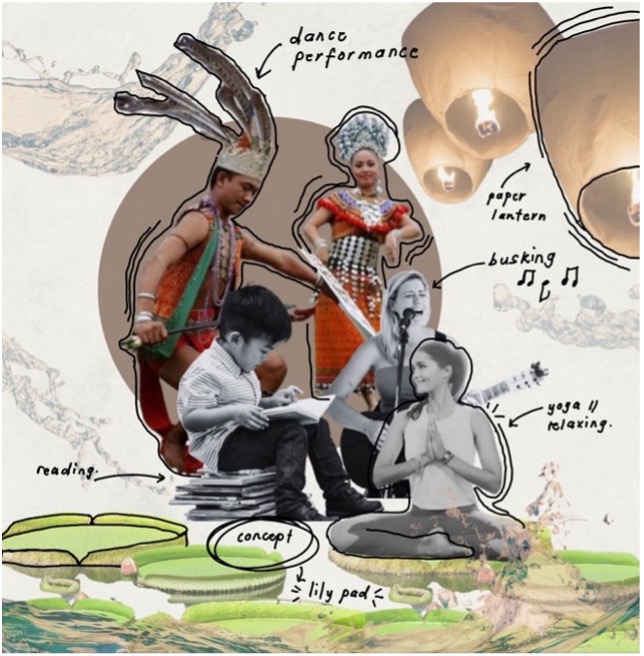
The Architecture Programme at the Faculty of Built Environment UNIMAS began its session again with the seventh batch currently enrolled in the second semester of their second year. This group of students called their batch ‘Arkana’, a combination of ‘architecture’ and ‘ohana’, a Hawaiian word meaning ‘family’. Arkana signifies a community and a family, a strong support group living under the architecture umbrella. Indeed, to survive in a course claimed by Harvard as ‘the most difficult course in the world’ not only requires a solid support system, but also a positive attitude toward criticism, a strong mind, and strong physical and mental endurance to stay ‘afloat’ throughout the course.
On a similar note, the first project to kick-start the semester has much to do with floating. The core course also coined as the most thrilling, namely BEA2136 Architectural Design Studio, invites the students to ‘think science, but produce art’. The course is coordinated by the Studio Master , Ts. Mohd. Anis Yaziq bin Alimin, and co-lectured by both Mdm Yon Syafni and Mdm Nadzirah Jausus. In groups of five, students are tasked with designing a floating structure to serve as a multifunctional space for student activities. The project uses UNIMAS lakes as an experimental site, for this floating structure could ideally be transported just about anywhere. With the requirement to accommodate two people standing or lying down, the students were also faced with spatial requirements, the pod should adhere to a maximum dimension of 3000mm long x 3000mm wide x 3000mm high.

From conceptual collage to final design. (Images Source: Herisky Den)

Students had three weeks to create a design that is cohesive, functional, and most importantly, floatable. The first week’s lectures revisited Archimedes’ principle, guiding their initial sketches and mock-up models. During design critiques, lecturers provided live feedback to students’ work, provided further refinement to their initial idea. The final week, marked by sleepless nights, they focused on perfecting presentation boards and constructing detailed 1:5 scale models, adding the final touches to their ambitious projects.

Two groups, led by Sherena Anak Freddie and Ray Bon Joel, drew their design inspiration from floating plants such as the lily pad and water hyacinth respectively, adopting the mechanism which enables these plants to stay afloat above the water surface into their design concept. Teaming up with Herisky Den, Delaney Dinang and Abigail Dara, Sherena’s group designed a performing stage at night which duals as a meditation space during the day. Illuminated by LED strip light along the stage platform, the ‘Lumina’ renders a unique performance stage on water, that moves gently with the flow, like floating a paper lantern.


Another group, led by Nur Iman Aniesha binti Bolkiah, adopted the natural phenomena of an iceberg. Mimicking the reflective feature of the ice block and its subtle movement on the Artic, they deconstructed their ‘iceberg’ structure into modular parts that could easily be assembled and dissembled. The structure serves as a mini gallery to raise youth awareness of global climate change and rising water levels. Since each part is detached from the other, the platform for each section moves in an undulating motion, simply to mimic the iceberg.

Another noteworthy design came from Amir Hamzah bin Matnor’s group, who presented the ‘Hextapod.’ This innovative structure featured a hexagonal platform designed for stability and versatility on water. Meanwhile, Ivyvanessa Icha Anak Mini’s origami-inspired pod presents another promising design. Its innovative feature allows it to transform into a bird-like form, showcasing both functionality and aesthetics.


For the final presentation, the ability of the pods to float was crucial. We gathered at the lake near the Student Pavilion for a model-testing session. The weather was stunning, setting the perfect backdrop for this ‘moment of truth.’ All the models successfully floated, though the floating mechanisms were visible due to insufficient load. Heavier pods or designs covering the bottom edges would have achieved a more polished look.
The relief after a final presentation is unparalleled. For those needing major improvements, it was a bittersweet conclusion. However, for those who met every requirement and brought their concepts to life, it was the perfect time to head home and finally get some well-deserved rest.
By Yon Syafni Samat & Nadzirah Jausus, Faculty of Built Environment, Universiti Malaysia Sarawak

This article is related with Sustainable Development Goal (SDG 11) – Sustainable Cities and Communities